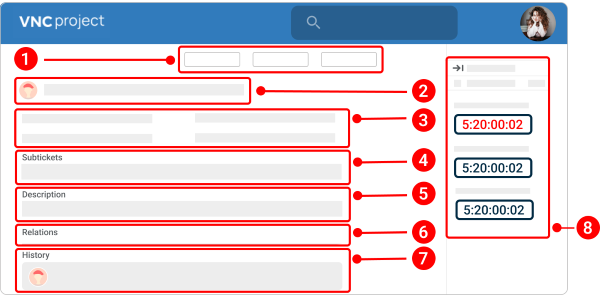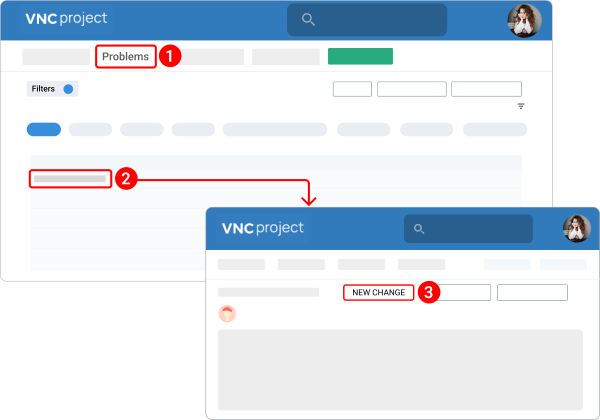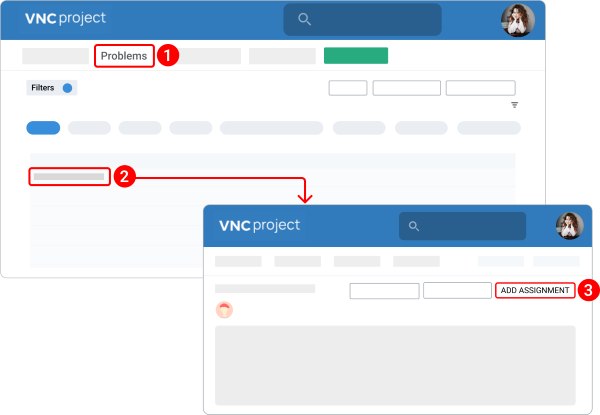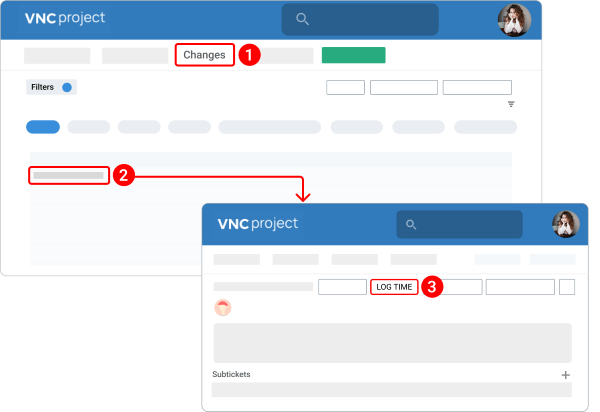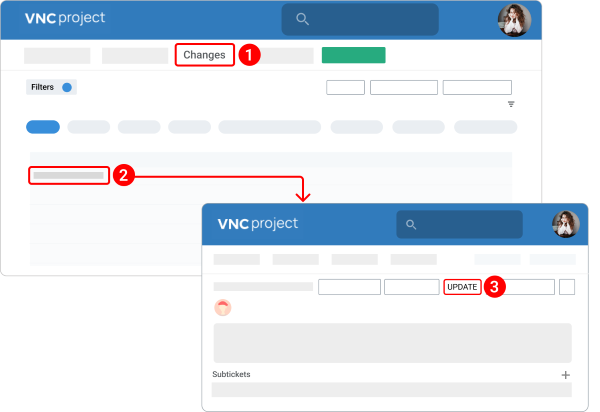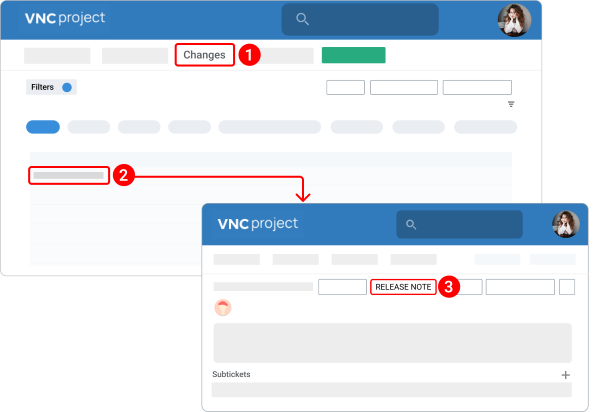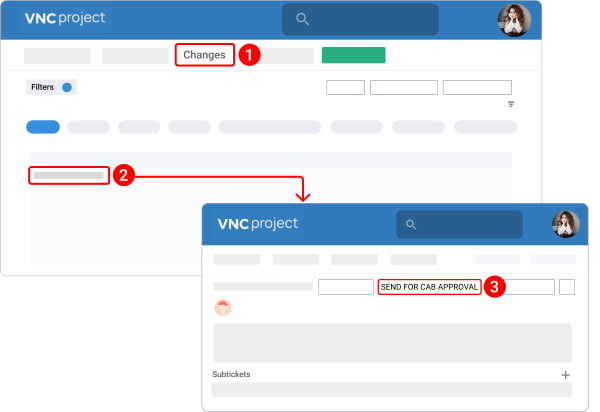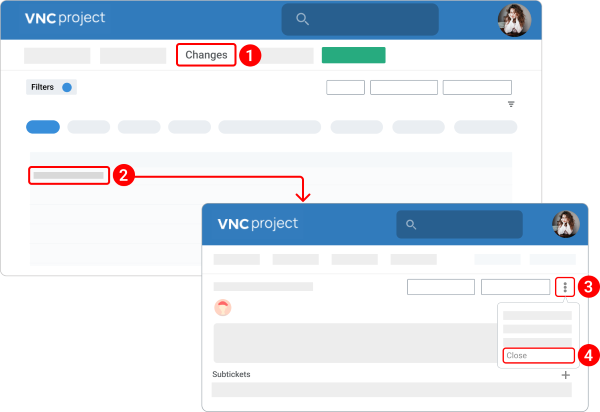VNC ITIL Change Management Manual¶
Change Management provides a systematic approach to controlling the lifecycle of all changes, making it easy to make useful changes with minimal disruption to IT services.
Quick Overview of Change¶
Change management is the process of controlling the life cycle of changes to IT services through standardized procedures. The goal of change management practices is to reduce incidents and meet regulatory standards.
Change refers to the addition, modification, or removal of something that may directly or indirectly affect the services.
To access all existing problems, navigate to Helpdesk > Changes.
The Change list page contains the following fields and functions:
- Filters: Sort existing changes by status, assignee, author, date when the incident was created or updated, and other criteria. The status filter is applied by default.
- Column Customization: Located in the upper right corner of the "Changes" table, click the column customization icon
 to show/ hide columns in the table view and manage their order.
to show/ hide columns in the table view and manage their order. - Status list: Change statuses indicate which phase a change is currently in. Change statuses let you define and communicate the overall progress of changes.
- Change table: Change view with many management options.
The Change detail page allows you to review and take action on a problem. Each change contains the following sections:
- Toolbar: A strip а control buttons that let you perform various actions on a change.
- Title bar: Shows basic change details including the title of the change.
- Change Information: Shows general details of the change such as Status, Priority, Product, Version, Platform, Urgency, Impact, Assignee, Requester, Due By Date, Closed Date, Used Hardware Type, Operating System, and Browser.
- Description: Contain a detailed description of a change.
- Subtickets: The table of subtickets. Click the plus icon to create a subticket for a change to either split the change into smaller chunks or to allow various aspects of a change to be assigned to different people.
- Relations: The table of related incidents, problems, tasks, and changes.
- History: Includes any change that might have been made to the change. It includes comments made, changes to status, priority, assignment, or root cause, and any subtickets that have been created.
- Time tracking: Tracks time spent on the change. Click the collapse arrow icon on the right to open the Time tracking section. From here, you can see a list of watchers added to a problem. You also have the option to add users as watchers or delete them by clicking Add or the trash bin icon.
Change statuses¶
There are 5 resolution statuses. The table below contains the statuses list and their short description:
| Status title | Short description |
|---|---|
| New | It means that a change is created and assigned to nobody |
| Assigned | It means that a change is assigned to a VNC Support Consultant |
| Under analysis | It means that the support team analyzes and works out the change impact, roll-out plan, backout plan, checklist, and downtime concerned with the change |
| Closed | It means that the support team assessed change plans and approved for change implementation |
| Rejected | It means that the support team doesn't agree with the change |
Create a change¶
There are 2 ways to create a change.
Way 1. From the "Change List" page.
- Navigate to Helpdesk > Changes.
- Click the NEW CHANGE button.
-
Fill in the fields:
- In the Subject field, type the name of a change.
- From the Project dropdown, you can change the project you want to add a change to.
- From the Customer dropdown, you can change the customer.
- From the Requested for dropdown, you can select another user from your organization and they will become an owner of this change. By default, there is a name of a person who creates a change.
- From the Product dropdown, select the product where a change need to be implemented.
- From the Version dropdown, select the version where a change need to be implemented. The dropdown menu contains only those versions that are available for a selected VNC product from the Product menu.
- From the Impact dropdown, identify the impact area.
- From the Urgency dropdown, identify the urgency level.
- From the Used hardware type dropdown, identify a hardware type where a change need to be implemented.
- From the Operating system dropdown, select the operation system where a change need to be implemented. The dropdown menu contains only those operating systems that are available for a selected hardware type from the Used hardware type menu.
- From the Browser dropdown, select the browser where a change need to be implemented. The dropdown menu contains only those types of browsers that are available for a selected operating system from the Operating system menu.
- From the Platform dropdown, select the platform where a change need to be implemented.
-
Enter a detailed description of a change.
- In the Priority field, set the priority to Immediate, Urgent, High, Normal, and Low.
- Click Create.
Way 2. From the "Problem details" page.
You can open a new problem from the Incident details page only if it has "Assigned", "In progress", or "Pending - Other Incident" status and it is accessible in the respective tab.
- Navigate to Helpdesk > Problems.
- Open a problem.
- Click the New Change button.
- The further steps are the same as the first way of creating a change.
Assign a change¶
You can add an assignment to a change only if it has "New", "Assigned", and "Closed" status and it is accessible in the respective tab.
You can add an assignment to a change to either split the issue into smaller chunks or allow various aspects of an issue to be assigned to different people.
- Navigate to Helpdesk > Changes.
- Open a change.
- Click the ADD ASSIGNMENT button.
- From the Role dropdown menu, specify a role.
- From the Assign to dropdown menu, specify a user account.
- (Optional) Add a note and make it internal by checking the box next to Internal Notes.
- (Optional) Under the Attachments section, click the plus icon and select the images/ files you want to add.
- Click Submit.
Log time on a change¶
- Navigate to Helpdesk > Changes.
- Open a change.
- Click the LOG TIME button.
- Fill in the Hours and Comments fields.
- Click CREATE.
Analyze a change¶
You can analyze a change request if it has the "Assigned" status and it is accessible in the respective tab.
- Navigate to Helpdesk > Changes.
- Open a change.
- Click the ANALYSIS button.
- Fiil in all required fields.
- Click Save.
Update a change¶
Every single event that happens within the change is displayed in the History section located at the very end of the change:
- Navigate to Helpdesk > Changes.
- Open a change.
- Click the Update button.
- In the Notes section, enter your comment.
- Under the Attachments section, click the plus icon to attach a file/ screenshot.
- Click SUBMIT.
Create a release note¶
You can create a release note only if it has "Assigned" status and it is accessible in the "Assigned" tab.
- Navigate to Helpdesk > Changes.
- Open a change.
- Click the NEW RELEASE button.
-
Fill in the fields:
- Subject: Specify the title of the release note;
- Project: Select a required project from the dropdown menu;
- Customer: Select a required customer from the dropdown menu;
- Requested for: Select the user who manages all aspects of the end-to-end release process;
- Product: Select the product from the dropdown menu;
- Impact: Identify the impact area by selecting All users, Group of users, and Only one user;
- Release type: Identify the release type by selecting Minor, Major, Standard, or Immediate;
- Planned start date: the earliest possible date you can begin working on a release;
- Due date: the date when you would ideally like to have the release completed.
-
Enter a detailed description of a release.
- Under the Attachments section, click the plus icon and select a required file/ image from your computer.
- Select a priority of a release — Low, Normal, High, Urgent, and Immediate.
- If you want to add some watchers, click +Search for watchers to add.
- Click Create.
Send for CAB approval¶
The Change Advisory Board (also known as CAB) plays a major role in the change management process.
A group of competent individuals must meet periodically to evaluate the proposed changes critically review them, and offer suggestions to the change manager.
- Navigate to Helpdesk > Changes.
- Open a change.
- Click the SEND FOR CAB APPROVAL button.
- Add your comment to the Notes field.
- Under the Attachments section, click the plus icon to attach a file/ screenshot.
- Click SUBMIT.
Note that If the mandatory fields are not entered, then an error message is shown asking you to enter the value in the fields.
Approve a change¶
You can approve a change request if it has the "Assigned" or "Closed" statuses and it is accessible in the respective tabs.
- Navigate to Helpdesk > Changes.
- Open a change.
- Click the kebab menu icon.
- Select Approve frpm the dropdown menu.
- In the Notes box, type your comment.
- Under the Attachments section, click the plus icon and select a required file/ image from your computer.
- Click Submit.
Note that If the mandatory fields are not entered, then an error message is shown asking you to enter the value in the fields.
Reject a change¶
In case you were not satisfied, you could click on "Reject" and add a remark to have the approval rejected.
- Navigate to Helpdesk > Changes.
- Open a change.
- Click the REJECT button.
- Add your comment to the Notes field.
- Under the Attachments section, click the plus icon to attach a file/ screenshot.
- Click SUBMIT.
Note that If the mandatory fields are not entered, then an error message is shown asking you to enter the value in the fields.
Complete a change¶
The change request can be completed only if it has the "Assigned" or "Closed" statuses and it is accessible in the respective tabs.
When the change request is complete, you can move the change request to "Completed" status. Once the Change Request is complete, it cannot be modified.
- Navigate to Helpdesk > Changes.
- Open a change.
- Click the kebab menu icon.
- Select COMPLETE from the dropdown menu.
- In the Notes box, type your comment.
- Under the Attachments section, click the plus icon and select a required file/ image from your computer.
- Click Submit.
Close a change¶
You can close a change request if it has the "Assigned" status and it is accessible in the respective tab.
- Navigate to Helpdesk > Changes.
- Open a change.
- Click the kebab menu icon.
- Select Close frpm the dropdown menu.
- In the Notes box, type your comment.
- Under the Attachments section, click the plus icon and select a required file/ image from your computer.
- Click Submit.
Note that If the mandatory fields are not entered, then an error message is shown asking you to enter the value in the fields.

